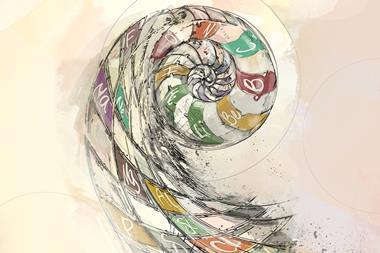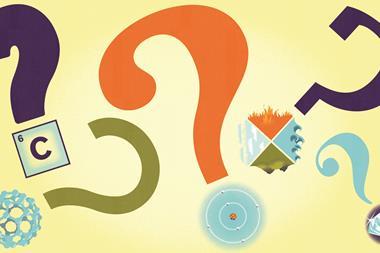As Dmitri Mendeleev’s iconic periodic table celebrates its 150th anniversary this year, two researchers have tried to understand what its ‘periodicity’ really means. The term reflects the recurrence of chemical properties down the list of elements, but even today ambiguities and arguments about the best way to represent those regularities in the table remain. Wilmer Leal and Guillermo Restrepo of the Max Planck Institute for Mathematics in the Sciences in Leipzig, Germany, hope that their mathematical analysis of the formal structure of ‘periodic systems’ like this might help to resolve some of those disputes.
There are two aspects to the periodic system of the elements – as Mendeleev first called it. First there is a sequential ordering of elements – Mendeleev did this according to atomic weight, but today the atomic number Z is recognised as more fundamental. Second there is the grouping of elements by similarity of properties. Yet there is no unique way to do that which is why, for example, it isn’t too clear where hydrogen should go, nor whether lanthanum or lutetium should sit beneath scandium and yttrium.
Rather than arguing about which table is the ‘right’ or ‘best’ one, the two researchers have looked for a mathematical description that encompasses all the options. ‘The several possibilities for ordering and classifying the elements bring up different periodic systems, and their relationships form a superstructure,’ says Restrepo. ‘There is no “final” periodic table, but there is a final superstructure containing them all.’
Setting the table
To characterise this ‘super-table’, you must choose criteria for ordering and similarity. Even though the first is generally taken now to be Z, it’s not obvious that this has to be so. Mendeleev needed to fudge the ordering by atomic weight to make his table fit with chemical properties, placing tellurium before iodine for example. Restrepo and Leal say that some theoretical studies of the periodic table extended up to a hypothetical 172 elements also demand order inversions of Z to accommodate similarities among electronic configurations. ‘The current ordering by atomic number might need re-evaluation to cope with the extension of the periodic system,’ says Restrepo.
The second element of the analysis is the similarities between the components of the system. These could be any chemical properties – for example, that sodium and potassium both combine with chlorine in a 1:1 ratio. ‘This approach was at the core of Mendeleev’s ideas,’ says Restrepo. ‘For him, an element was characterised by the elements it forms compounds with and the proportions of those combinations.’
Any shared property like this can be represented as a link in a graph that joins nodes representing the elements. The links need not merely be between two nodes – they can unite several at once. Restrepo compares it to three people playing in a musical trio: the connections aren’t just a set of binary links between pairs, but form a set. The resulting structure describing these relationships is called a hypergraph – like a network of ‘edges’ joining nodes, but with ‘hyper-edges’ representing also non-binary sets.
All possible periodic tables can thus be encompassed by a single hypergraph that defines the relationships between sets of elements. Any given table is a particular projection of this hypergraph. ‘Trying to force the periodic system into a single instance is too narrow,’ Restrepo says. ‘It’s like trying to make sense of a sculpture by only lighting it on one of its sides. Chemists in their daily work actually use different periodic systems, tailored to their needs. We are not really celebrating 150 years of a periodic table, but rather the underlying structure, full of chemical relations.’
New ways of seeing things
One potential benefit of this approach is that it can reveal how alternative representations of the table are related: whether, for example, they essentially show the same things in different ways. But the two researchers see their analysis as being applicable much more broadly, both within chemistry and beyond. For example, there are regularities, similarities and periodicities too in chemical compounds and bonds. Leal and Restrepo show how their hypergraph approach can be used to formulate a kind of periodic table of covalent bonding, which reveals recurring regularities in the nature of the bonds that each element forms.
But philosopher of chemistry Robin Hendry of Durham University questions the value of treating atomic number Z as just one possible ordering principle among others. ‘Z is arguably the foundational ordering feature of the periodic system,’ he says. ‘There may well be other ways of ordering the elements, but it’s trivial that such alternative orderings exist, and their significance needs to be demonstrated.’ Although Mendeleev used atomic weight, says Hendry, ‘it was really Z that underlay the similarities that were important to him. It’s what the chemistry of the elements was always about’.
Hendry wonders if the approach might shed light on whether chemists’ usual categories for grouping elements – for example, as alkali metals and halogens – are fundamental and unique or somewhat arbitrary and problem-specific. If higher order categories such as these groupings persist when elements are grouped by similarity for different kinds of chemical behaviour, that would indicate that the classification is robust and objective, he says.
Leal and Restrepo think that the methods of analysis could be useful beyond chemistry – for example, to characterise periodicities and regularities in social systems. But this mathematical approach to understanding periodic systems is still in its infancy, Restrepo says. ‘Mendeleev tried to come up with algebraic expressions for the periodic system, but he concluded that maths was not ripe enough to cope with the complexity. Here too, the maths of ordered hypergraphs is rather new, and there are many things still to do.’
References
1 W Leal and G Restrepo, Proc. R. Soc. A, 2019, DOI: 10.1098/rspa.2018.0581

















2 readers' comments